Modeling and Optimization of Directly Modulated Piezoelectric Micromachined Ultrasonic Transducers
Abstract
1. Introduction
2. Materials and Methods
2.1. System Design of the dMUT
2.2. Modeling of an Individual pMUT
2.3. Simulation of the dMUT
3. Results
3.1. Energy Consumption
3.2. System Optimization
3.2.1. Modulation Frequency (fm)
3.2.2. Array Dimension (N × N)
3.2.3. Capacitance Ratio (CR)
3.2.4. Frequency Ratio (FR)
3.2.5. High Performance dMUT
4. Discussion
Author Contributions
Funding
Data Availability Statement
Conflicts of Interest
References
- Ergun, A.S.; Yaralioglu, G.G.; Khuri-Yakub, B.T. Capacitive Micromachined Ultrasonic Transducers: Theory and Technology. J. Aerosp. Eng. 2003, 16, 76–84. Available online: https://ascelibrary.org/doi/abs/10.1061/%28ASCE%290893-1321%282003%2916%3A2%2876%29 (accessed on 23 December 2020). [CrossRef]
- Ergun, A.S.; Huang, Y.; Zhuang, X.; Oralkan, Ö.; Yaralıoglu, G.G.; Khuri-Yakub, B.T. Capacitive Micromachined Ultrasonic Transducers: Fabrication Technology. IEEE Trans. Ultrason. Ferroelectr. Freq. Control 2005, 52, 2242–2258. [Google Scholar] [PubMed]
- Akasheh, F.; Fraser, J.D.; Bose, S.; Bandyopadhyay, A. Piezoelectric micromachined ultrasonic transducers: Modeling the influence of structural parameters on device performance. IEEE Trans. Ultrason. Ferroelectr. Freq. Control 2005, 52, 455–468. [Google Scholar] [CrossRef] [PubMed]
- Muralt, P.; Ledermann, N.; Paborowski, J.; Barzegar, A.; Gentil, S.; Belgacem, B.; Petitgrand, S.; Bosseboeuf, A.; Setter, N. Piezoelectric micromachined ultrasonic transducers based on PZT thin films. IEEE Trans. Ultrason. Ferroelectr. Freq. Control 2005, 52, 2276–2288. [Google Scholar] [CrossRef] [PubMed]
- Tang, H.; Lu, Y.; Fung, S.; Tsai, J.M.; Daneman, M.; Horsley, D.A.; Boser, B.E. Pulse-echo ultrasonic fingerprint sensor on a chip. In Proceedings of the 2015 Transducers—2015 18th International Conference on Solid-State Sensors, Actuators and Microsystems, TRANSDUCERS 2015, Anchorage, AK, USA, 21–25 June 2015; Institute of Electrical and Electronics Engineers Inc.: New York, NY, USA, 2015; pp. 674–677. [Google Scholar]
- Horsley, D.A.; Lu, Y.; Tang, H.Y.; Jiang, X.; Boser, B.E.; Tsai, J.M.; Ng, E.J.; Daneman, M.J. Ultrasonic fingerprint sensor based on a PMUT array bonded to CMOS circuitry. In Proceedings of the IEEE International Ultrasonics Symposium, IUS, Tours, France, 18–21 September 2016; IEEE Computer Society: Piscataway, NJ, USA, 2016. [Google Scholar]
- Jiang, X.; Tang, H.Y.; Lu, Y.; Ng, E.J.; Tsai, J.M.; Boser, B.E.; Horsley, D.A. Ultrasonic Fingerprint Sensor with Transmit Beamforming Based on a PMUT Array Bonded to CMOS Circuitry. IEEE Trans. Ultrason. Ferroelectr. Freq. Control 2017, 64, 1401–1408. [Google Scholar] [CrossRef] [PubMed]
- Liu, X.; Chen, X.; Le, X.; Xu, Z.; Wu, C.; Xie, J. A High-Performance Square pMUT for Range-finder. In Proceedings of the NEMS 2018—13th Annual IEEE International Conference on Nano/Micro Engineered and Molecular Systems, Singapore, 22–26 April 2018; Institute of Electrical and Electronics Engineers Inc.: New York, NY, USA, 2018; pp. 115–118. [Google Scholar]
- Rozen, O.; Block, S.T.; Mo, X.; Bland, W.; Hurst, P.; Tsai, J.M.; Daneman, M.; Amirtharajah, R.; Horsley, D.A. Monolithic MEMS-CMOS ultrasonic rangefinder based on dual-electrode PMUTs. In Proceedings of the IEEE International Conference on Micro Electro Mechanical Systems (MEMS), Shanghai, China, 24–28 January 2016; Institute of Electrical and Electronics Engineers Inc.: New York, NY, USA, 2016; pp. 115–118. [Google Scholar]
- Zhou, Z.; Yoshida, S.; Tanaka, S. Monocrystalline PMNN-PZT thin film ultrasonic rangefinder with 2 m range at 1 volt drive. In Proceedings of the TRANSDUCERS 2017—19th International Conference on Solid-State Sensors, Actuators and Microsystems, Kaohsiung, Taiwan, 18–22 June 2017; Institute of Electrical and Electronics Engineers Inc.: New York, NY, USA, 2017; pp. 167–170. [Google Scholar]
- Basaeri, H.; Yu, Y.; Young, D.; Roundy, S. Acoustic power transfer for biomedical implants using piezoelectric receivers: Effects of misalignment and misorientation. J. Micromech. Microeng. 2019, 29, 084004. Available online: https://iopscience.iop.org/article/10.1088/1361-6439/ab257f (accessed on 14 November 2020). [CrossRef]
- Mehdizadeh, E.; Piazza, G. AlN on SOI pMUTs for ultrasonic power transfer. In Proceedings of the IEEE International Ultrasonics Symposium, IUS, Washington, DC, USA, 6–9 September 2017; IEEE Computer Society: Piscataway, NJ, USA, 2017. [Google Scholar]
- Herrera, B.; Pop, F.; Cassella, C.; Rinaldi, M. AlN PMUT-based Ultrasonic Power Transfer Links for Implantable Electronics. In Proceedings of the 2019 20th International Conference on Solid-State Sensors, Actuators and Microsystems and Eurosensors XXXIII, TRANSDUCERS 2019 and EUROSENSORS XXXIII, Berlin, Germany, 23–27 June 2019; Institute of Electrical and Electronics Engineers Inc.: New York, NY, USA, 2019; pp. 861–864. [Google Scholar]
- Dausch, D.E.; Gilchrist, K.H.; Carlson, J.R.; Castellucci, J.B.; Chou, D.R.; Von Ramm, O.T. Improved pulse-echo imaging performance for flexure-mode pMUT arrays. In Proceedings of the IEEE Ultrasonics Symposium, San Diego, CA, USA, 11–14 October 2010; pp. 451–454. [Google Scholar]
- Qiu, Y.; Gigliotti, J.; Wallace, M.; Griggio, F.; Demore, C.; Cochran, S.; Trolier-McKinstry, S. Piezoelectric Micromachined Ultrasound Transducer (PMUT) Arrays for Integrated Sensing, Actuation and Imaging. Sensors 2015, 15, 8020–8041. Available online: https://www.mdpi.com/1424-8220/15/4/8020 (accessed on 23 December 2020). [CrossRef] [PubMed]
- Akhbari, S.; Sammoura, F.; Shelton, S.; Yang, C.; Horsley, D.; Lin, L. Highly responsive curved aluminum nitride PMUT. In Proceedings of the IEEE International Conference on Micro Electro Mechanical Systems (MEMS), San Francisco, CA, USA, 26–30 January 2014; Institute of Electrical and Electronics Engineers Inc.: New York, NY, USA, 2014; pp. 124–127. [Google Scholar]
- Yang, Y.; Tian, H.; Wang, Y.-F.; Shu, Y.; Zhou, C.-J.; Sun, H.; Zhang, C.H.; Chen, H.; Ren, T.L. An Ultra-High Element Density pMUT Array with Low Crosstalk for 3-D Medical Imaging. Sensors 2013, 13, 9624–9634. Available online: https://www.mdpi.com/1424-8220/13/8/9624 (accessed on 23 December 2020). [CrossRef]
- Smyth, K.M.; Sodini, C.G.; Kim, S.G. High electromechanical coupling piezoelectric micro-machined ultrasonic transducer (PMUT) elements for medical imaging. In Proceedings of the TRANSDUCERS 2017-19th International Conference on Solid-State Sensors, Actuators and Microsystems, Kaohsiung, Taiwan, 18–22 June 2017; Institute of Electrical and Electronics Engineers Inc.: New York, NY, USA, 2017; pp. 966–969. [Google Scholar]
- Pop, F.V.; Herrera, B.; Cassella, C.; Chen, G.; Demirors, E.; Guida, R.; Melodia, T.; Rinaldi, M. Novel pMUT-Based Acoustic Duplexer for Underwater and Intrabody Communication. In Proceedings of the 2018 IEEE International Ultrasonics Symposium (IUS), Kobe, Japan, 22–25 October 2018; pp. 1–4. [Google Scholar]
- Pop, F.; Herrera, B.; Zhu, W.; Assylbekova, M.; Cassella, C.; McGruer, N.; Rinaldi, M. Zero-Power Acoustic Wake-Up Receiver based on dMUT Transmitter, pMUTs Arrays Receivers and MEMS Switches for Intrabody Links. In Proceedings of the Transducers-Eurosensors, 2019 IEEE International, Berlin, Germany, 23–27 June 2019. [Google Scholar]
- Sadeghpour, S.; Kraft, M.; Puers, R. Highly Efficient Piezoelectric Micromachined Ultrasound Transducer (PMUT) for Underwater Sensor Networks. In Proceedings of the 2019 20th International Conference on Solid-State Sensors, Actuators and Microsystems and Eurosensors XXXIII, TRANSDUCERS 2019 and EUROSENSORS XXXIII, Berlin, Germany, 23–27 June 2019; Institute of Electrical and Electronics Engineers Inc.: New York, NY, USA, 2019; pp. 162–165. [Google Scholar]
- Sadeghpour, S.; Kraft, M.; Puers, R. PMUTs Array with Dynamic Directivity: A Study of its Underwater Acoustic Power Intensity. In Proceedings of the IEEE International Ultrasonics Symposium, IUS, Kobe, Japan, 22–25 October 2018; IEEE Computer Society: Piscataway, NJ, USA, 2018. [Google Scholar]
- Liu, W.; He, L.; Wang, X.; Zhou, J.; Xu, W.; Smagin, N.; Toubal, M.; Yu, H.; Gu, Y.; Xu, J.; et al. 3D FEM Analysis of High-Frequency AlN-Based PMUT Arrays on Cavity SOI. Sensors 2019, 19, 4450. Available online: https://www.mdpi.com/1424-8220/19/20/4450 (accessed on 23 December 2020). [CrossRef] [PubMed]
- Keller, S.D.; Palmer, W.D.; Joines, W.T. Direct antenna modulation: Analysis, design, and experiment. In Proceedings of the IEEE Antennas and Propagation Society, AP-S International Symposium (Digest), Albuquerque, NM, USA, 9–14 July 2006; pp. 909–912. [Google Scholar]
- Babakhani, A.; Rutledge, D.B.; Hajimiri, A. Transmitter architectures based on near-field direct antenna modulation. IEEE J. Solid-State Circuits 2008, 43, 2674–2692. [Google Scholar] [CrossRef]
- Yao, W.; Wang, Y. Direct antenna modulation-A promise for ultra-wideband (UWB) transmitting. In Proceedings of the IEEE MTT-S International Microwave Symposium Digest, Fort Worth, TX, USA, 6–11 June 2004; pp. 1273–1276. [Google Scholar]
- Fusco, V.F. Direct-signal modulation using a silicon microstrip patch antenna. IEEE Trans. Antennas Propag. 1999, 47, 1025–1028. [Google Scholar] [CrossRef]
- Babakhani, A.; Rutledge, D.; Hajimiri, A. Near-field direct antenna modulation. IEEE Microw. Mag. 2009, 10, 36–46. [Google Scholar] [CrossRef]
- Pop, F.V.; Herrera, B.; Cassella, C.; Rinaldi, M. Direct modulation piezoelectric micro-machined ultrasonic transducer system (dmut). In Proceedings of the 2019 IEEE 32nd International Conference on Micro Electro Mechanical Systems (MEMS), Seoul, Korea, 27–31 January 2019; pp. 61–64. [Google Scholar]
- Huang, C.H.; Gao, H.; Torri, G.B.; Mao, S.; Jeong, Y.; Cheyns, D.; Rochus, V.; Rottenberg, X. Design, modelling, and characterization of display compatible pMUT device. In Proceedings of the 2018 19th International Conference on Thermal, Mechanical and Multi-Physics Simulation and Experiments in Microelectronics and Microsystems, EuroSimE 2018, Toulouse, France, 15–18 April 2018; Institute of Electrical and Electronics Engineers Inc.: New York, NY, USA, 2018; pp. 1–4. [Google Scholar]
- Amar ABen Cao, H.; Kouki, A.B. Modeling and process design optimization of a piezoelectric micromachined ultrasonic transducers (PMUT) using lumped elements parameters. Microsyst. Technol. 2017, 23, 4659–4669. Available online: https://link.springer.com/article/10.1007/s00542-016-3205-8 (accessed on 23 December 2020). [CrossRef]
- Smyth, K.M. Design and Modeling of a PZT Thin Film Based Piezoelectric Micromachined Ultrasonic Transducer (PMUT). Ph.D. Thesis, Massachusetts Institute of Technology, Cambridge, MA, USA, 2012. Available online: https://dspace.mit.edu/handle/1721.1/74942 (accessed on 23 December 2020).
- Pop, F.; Herrera, B.; Cassella, C.; Rinaldi, M. Enabling Real-Time Monitoring of Intrabody Networks through the Acoustic Discovery Architecture. IEEE Trans. Ultrason. Ferroelectr. Freq. Control 2020, 67, 2336–2344. [Google Scholar] [CrossRef] [PubMed]


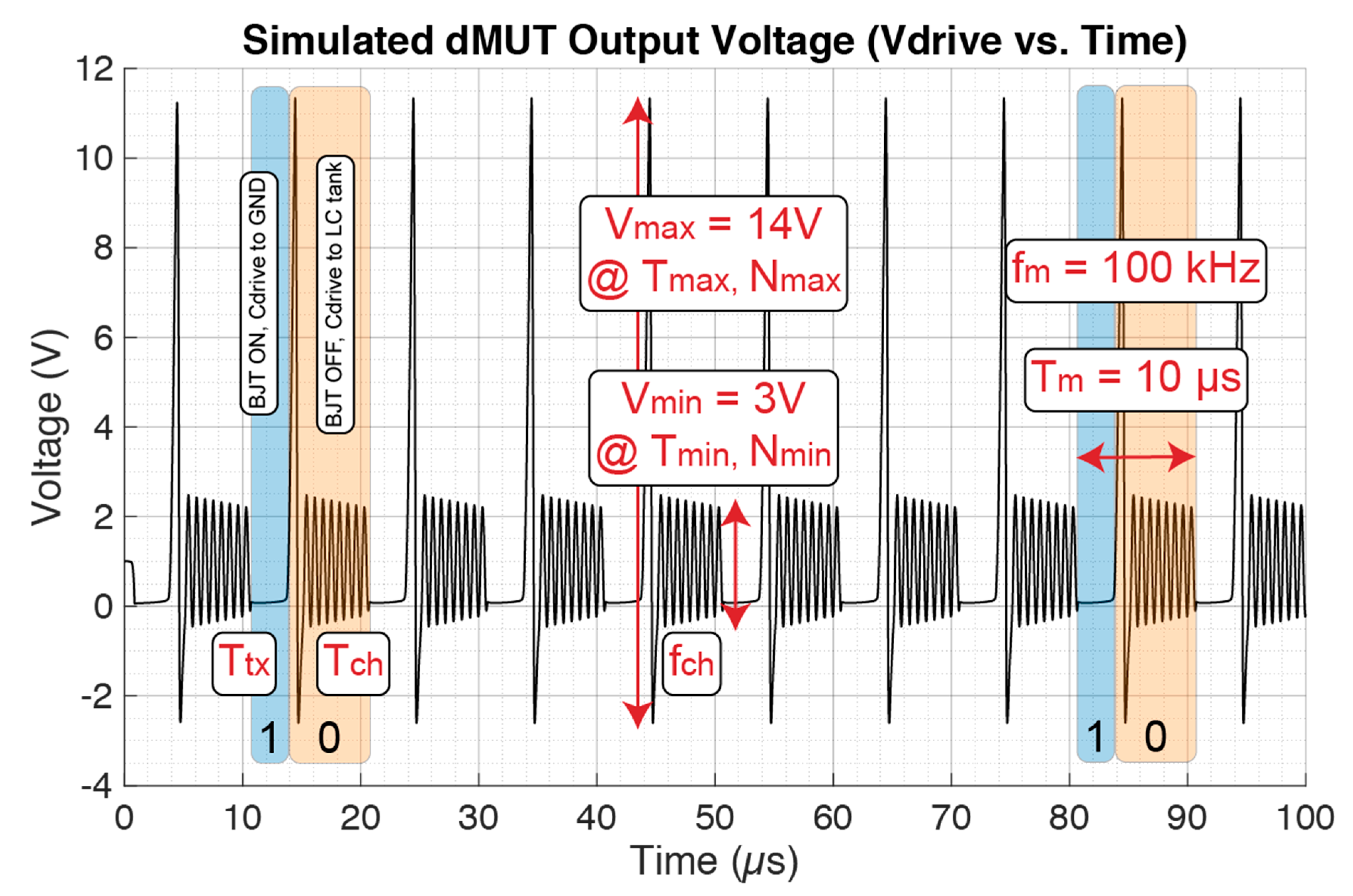
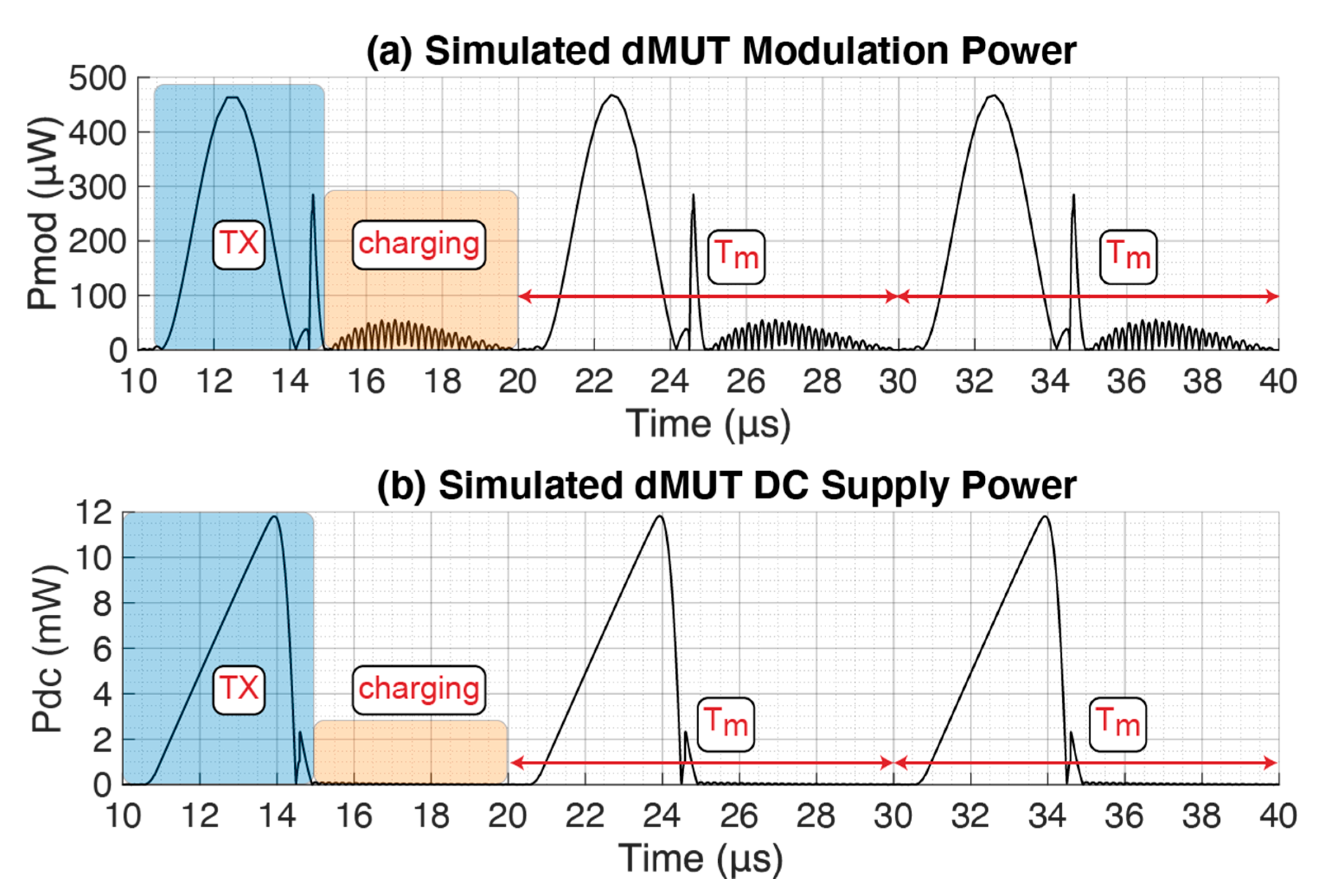
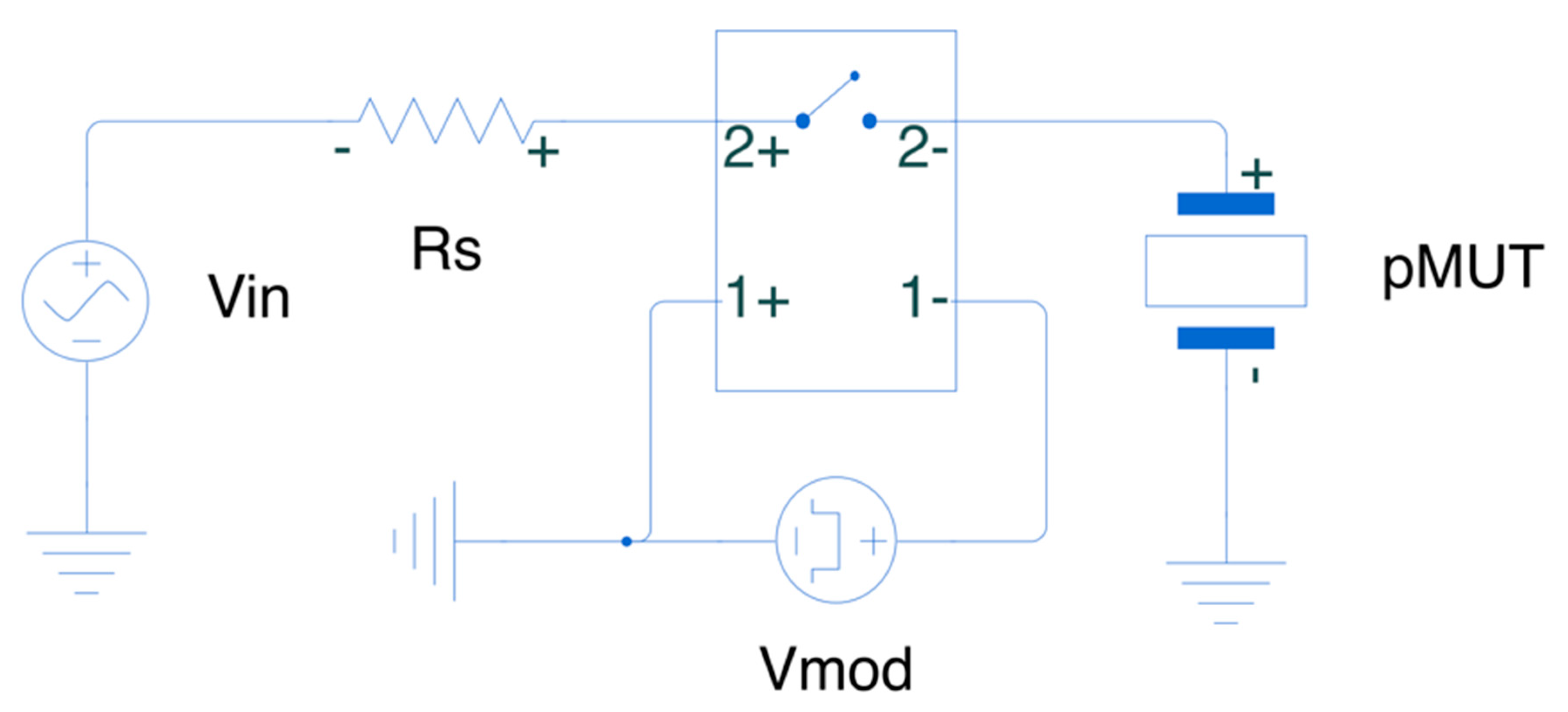

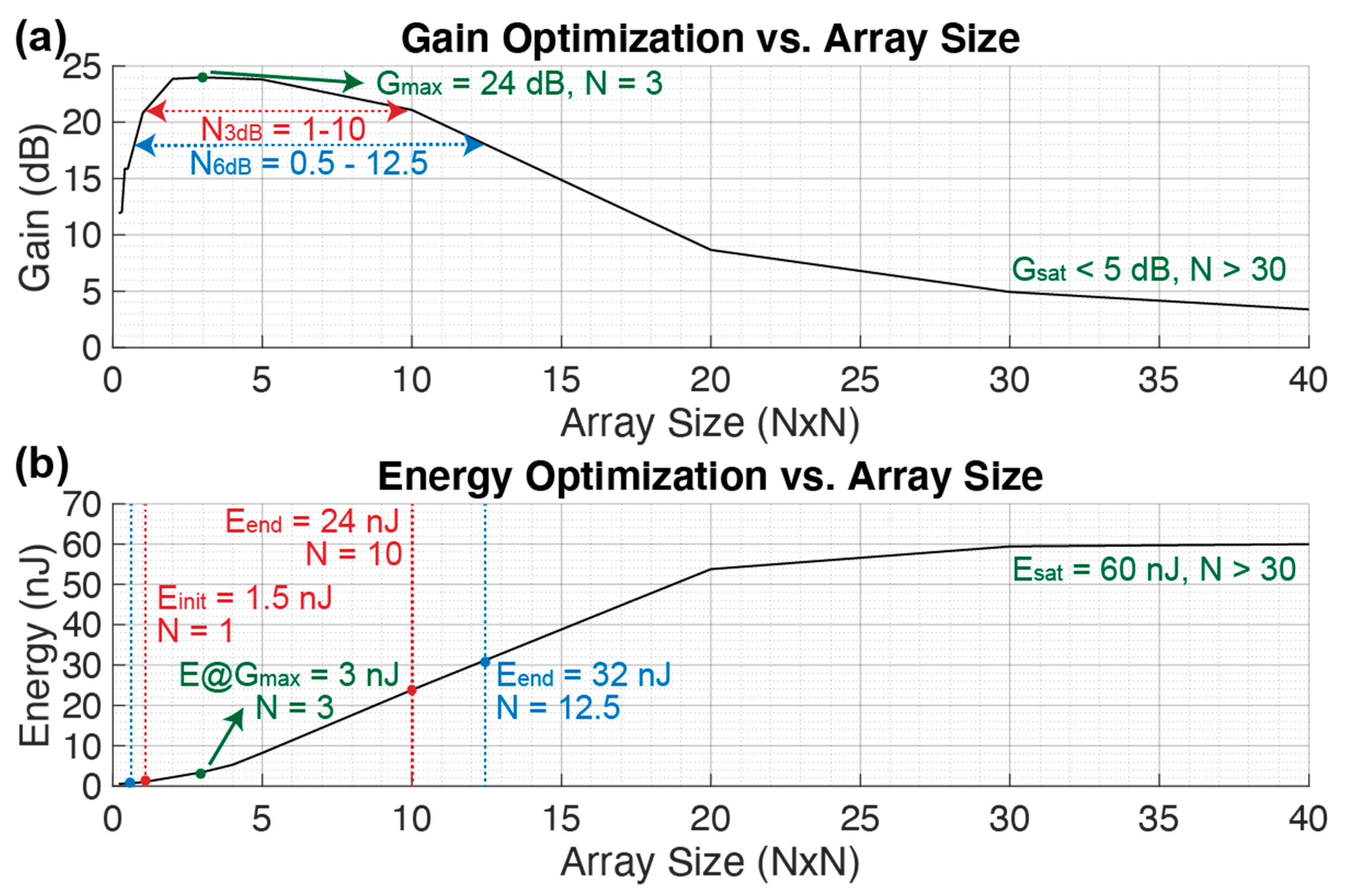
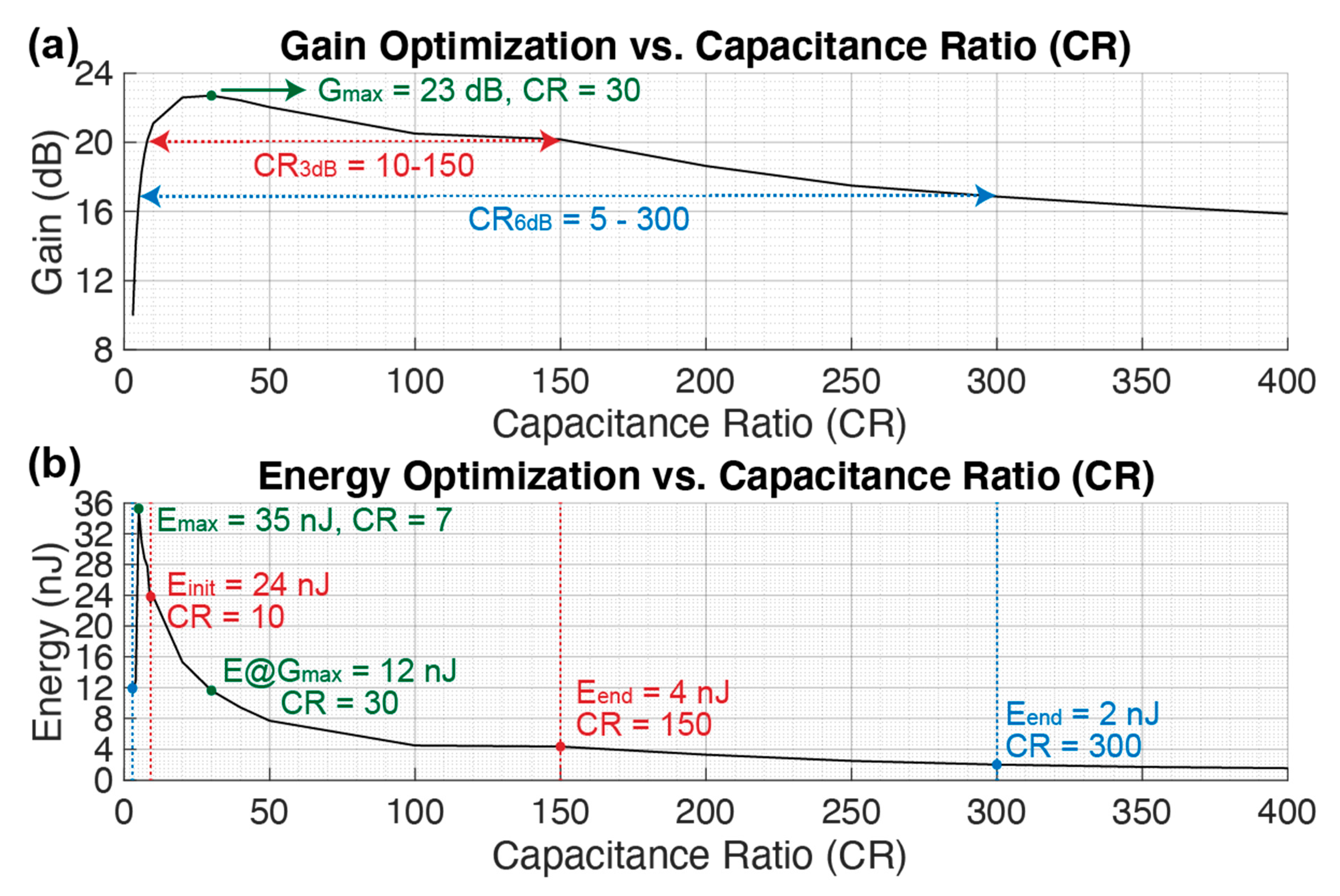
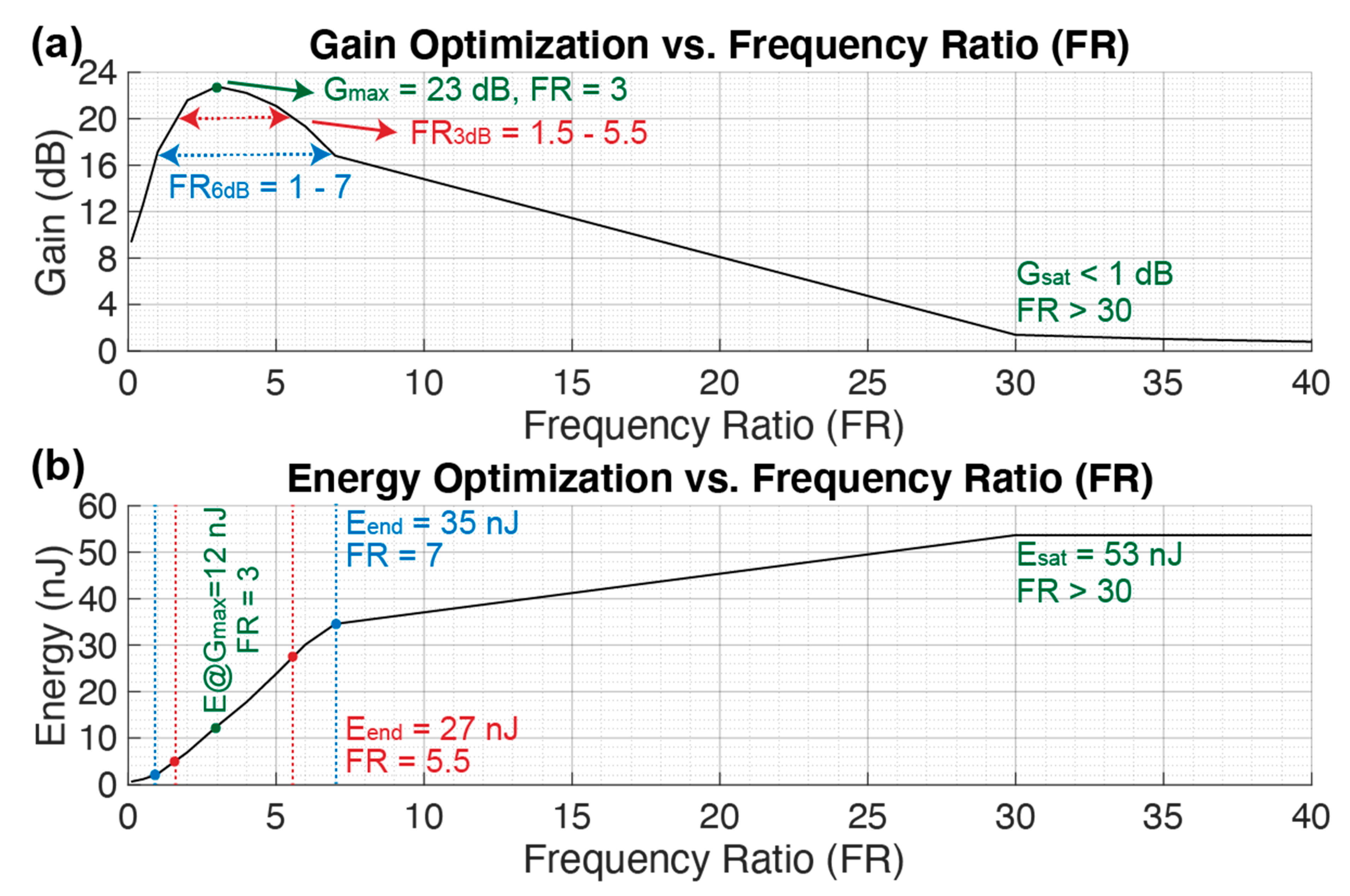
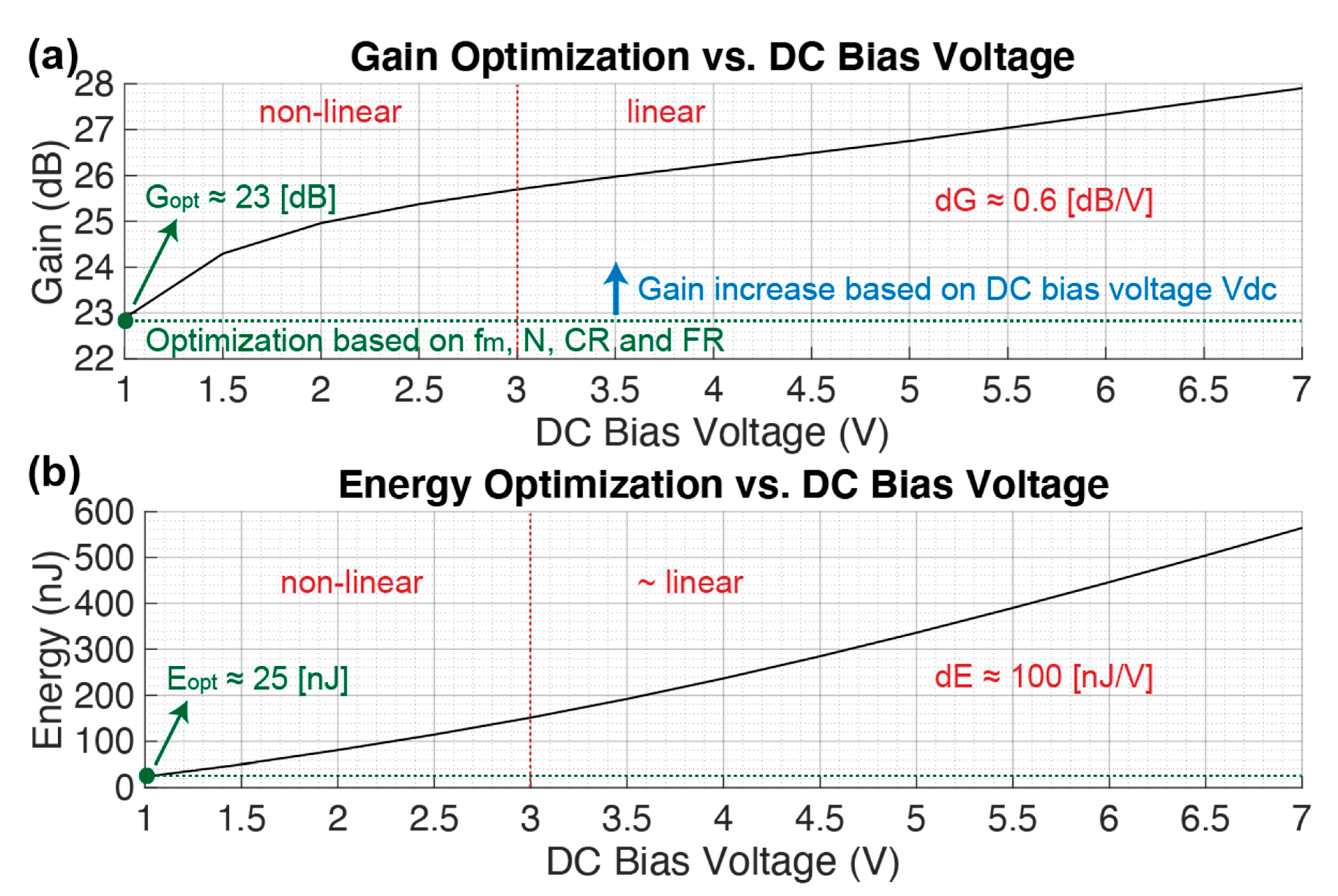
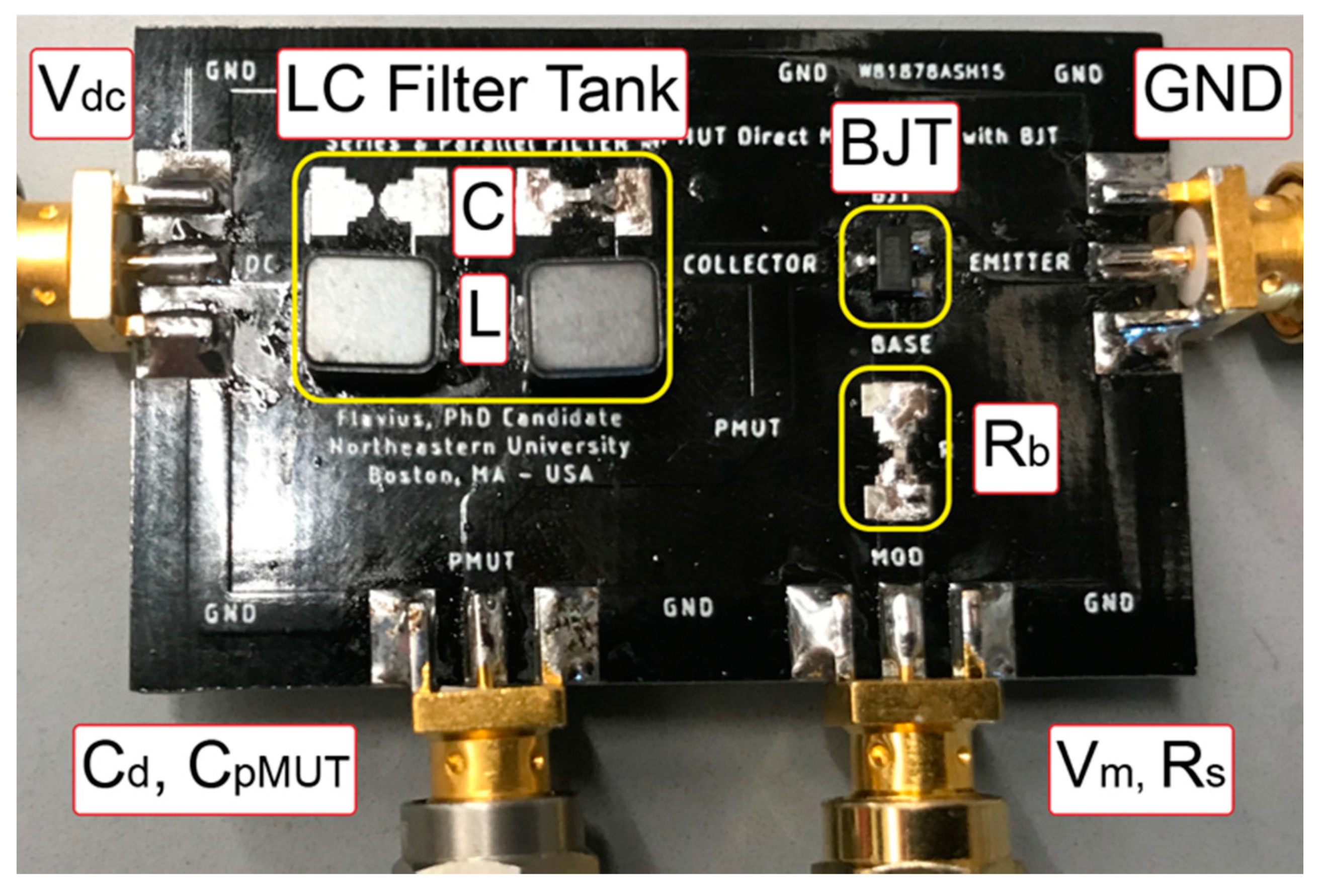

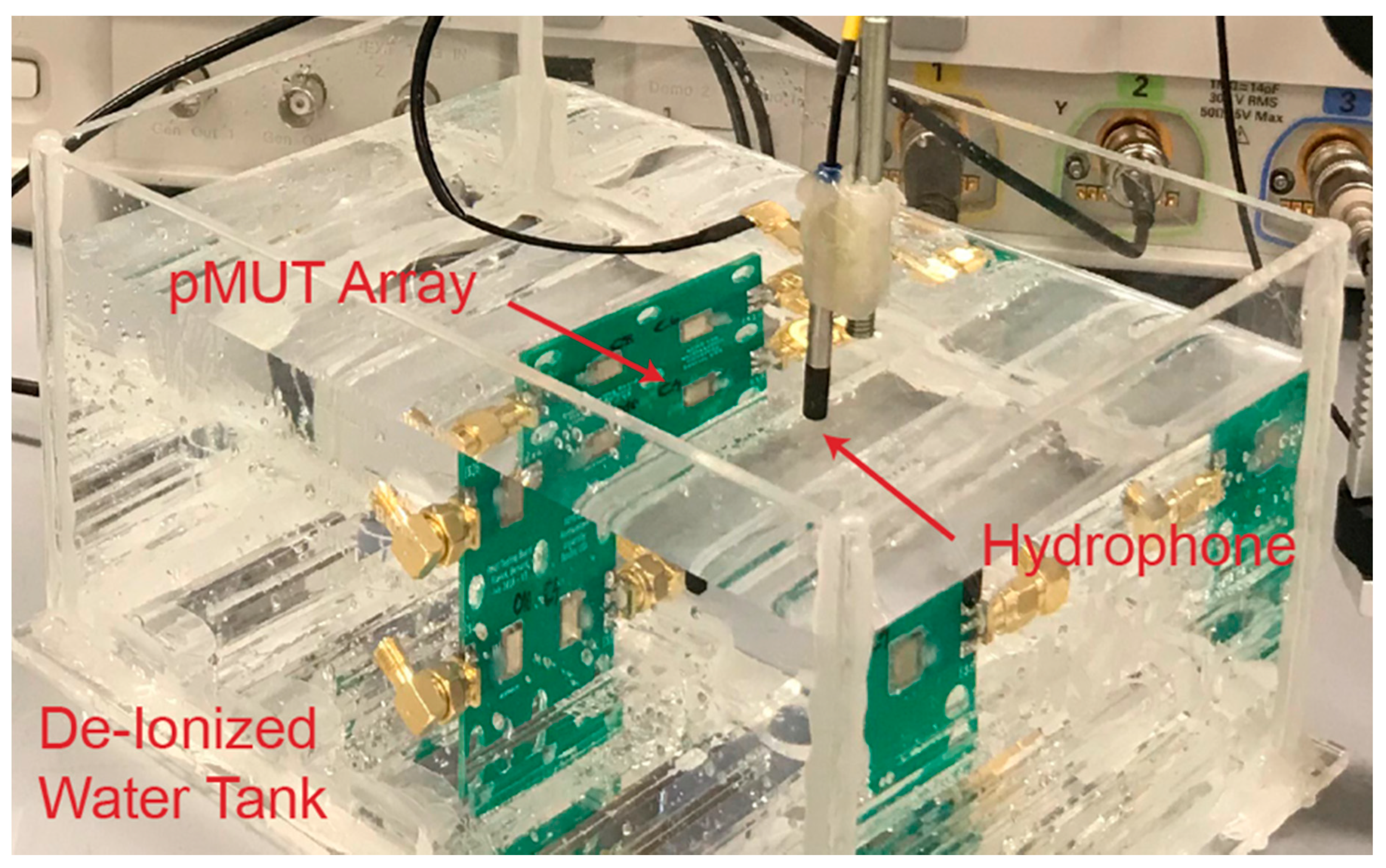
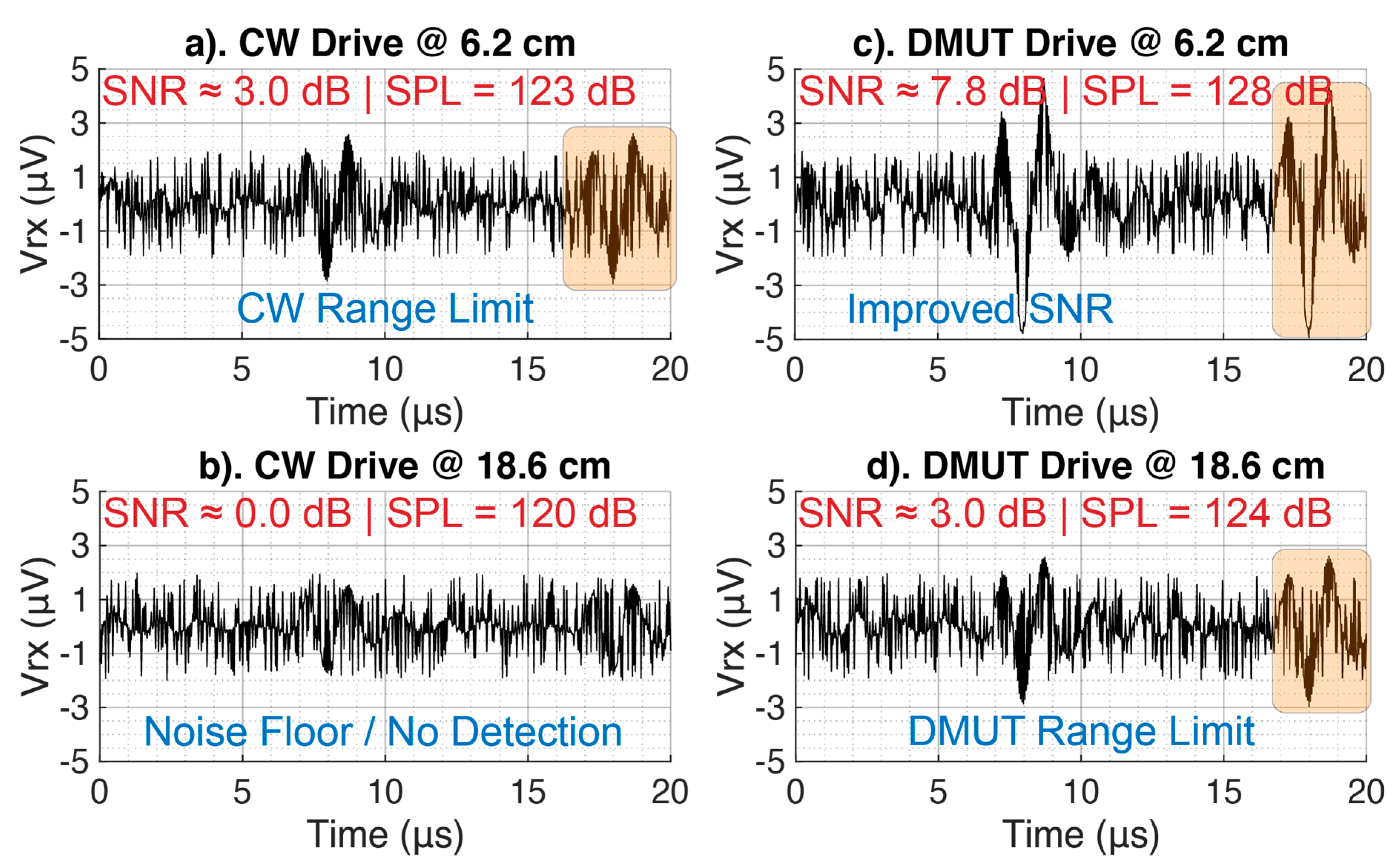
| Parameter | Value | Description |
|---|---|---|
| Vm | 1 [V] | AC input voltage amplitude |
| fm | 100 [kHz] | Modulation frequency |
| Rs | 50 [Ω] | Input source resistance |
| Rb | 1 [kΩ] | BJT base biasing resistance |
| Vdc | 1 [V] | DC biasing voltage of LC tank |
| fpMUT | 1 [MHz] | Resonance frequency of pMUT |
| FR | LC tank to pMUT frequency ratio | |
| ftank | LT tank resonance frequency | |
| N, M | N = 10, M = 10 | Rows and columns of single pMUT |
| CpMUT | 0.5 [pF] | Static capacitance of single pMUT |
| Cdrive | Driving capacitance of dMUT | |
| CR | LC tank to driving capacitance ratio | |
| Ctank | LC tank capacitance | |
| Ltank | LC tank inductance |
| Parameter | Sweeping Variables (SV) [U] | |||
|---|---|---|---|---|
| fm [kHz] | N [1] | CR [1] | FR [1] | |
| Gmax [dB] | 21 | 24 | 23 | 23 |
| SV @ Gmax [U] | 150 | 3 | 30 | 3 |
| E @ Gmax [nJ] | 12 | 3 | 12 | 12 |
| Emax [nJ] | 24 | Esat | 35 | Esat |
| SV3dB [U] | 75–450 | 1–10 | 10–150 | 1.5–5.5 |
| SV6dB [U] | 50–600 | 0.5–12.5 | 5–300 | 1–7 |
| E3dB [nJ] | 23–3 | 1.5–24 | 24–4 | 5–27 |
| E6dB [nJ] | 18–1 | 0.5–32 | 12–Emax–2 | 2–35 |
| Gsat [dB] | n/a | <5 | n/a | <1 |
| Esat [nJ] | n/a | 60 | n/a | 53 |
| SVsat [U] | n/a | >30 | n/a | >30 |
Publisher’s Note: MDPI stays neutral with regard to jurisdictional claims in published maps and institutional affiliations. |
© 2020 by the authors. Licensee MDPI, Basel, Switzerland. This article is an open access article distributed under the terms and conditions of the Creative Commons Attribution (CC BY) license (http://creativecommons.org/licenses/by/4.0/).
Share and Cite
Pop, F.; Herrera, B.; Cassella, C.; Rinaldi, M. Modeling and Optimization of Directly Modulated Piezoelectric Micromachined Ultrasonic Transducers. Sensors 2021, 21, 157. https://doi.org/10.3390/s21010157
Pop F, Herrera B, Cassella C, Rinaldi M. Modeling and Optimization of Directly Modulated Piezoelectric Micromachined Ultrasonic Transducers. Sensors. 2021; 21(1):157. https://doi.org/10.3390/s21010157
Chicago/Turabian StylePop, Flavius, Bernard Herrera, Cristian Cassella, and Matteo Rinaldi. 2021. "Modeling and Optimization of Directly Modulated Piezoelectric Micromachined Ultrasonic Transducers" Sensors 21, no. 1: 157. https://doi.org/10.3390/s21010157
APA StylePop, F., Herrera, B., Cassella, C., & Rinaldi, M. (2021). Modeling and Optimization of Directly Modulated Piezoelectric Micromachined Ultrasonic Transducers. Sensors, 21(1), 157. https://doi.org/10.3390/s21010157






